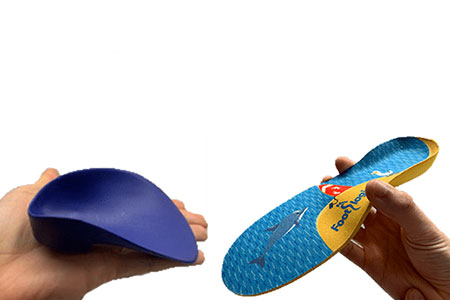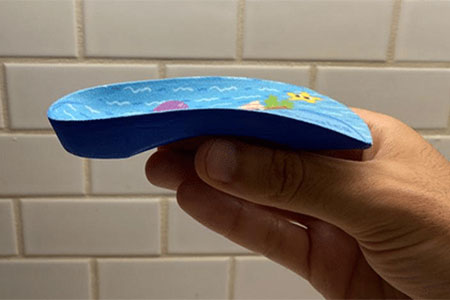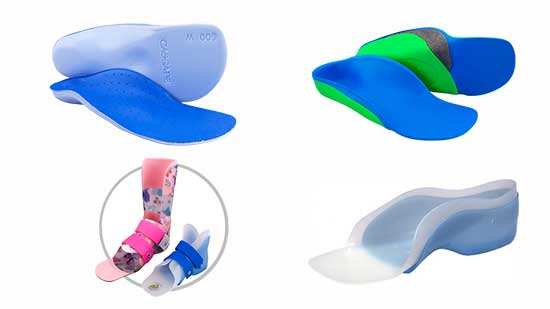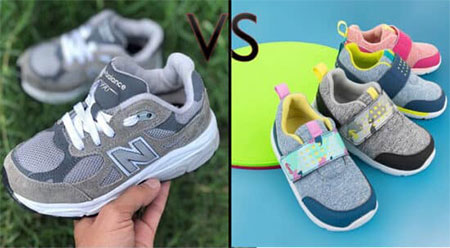What is the Difference Between 3/4 and Full Length Orthotics? – Choose the Right One for Your Child!

Has your child been diagnosed with a specific foot condition that requires him or her to wear orthotics inside the shoes? Are you wondering what is the difference between 3/4 and full length orthotics? This is a common question parents ask me at the specialized children’s shoe store that I work for, so let’s find out the answer and clear any doubts you might have about which orthotic will work best for your child’s foot condition.
Children’s orthotics come in all different shapes and sizes, and it can be overwhelming for parents to figure out which one is the ideal one for their children if they don’t have the guidance of a physical or occupational therapist.
What Are Full Length Orthotics?
Full length orthotics extend through the entire length of the foot. Take a look at the image below for better visualization purposes:

What Are 3/4 Length Orthotics?
3/4 length orthotics extend from the ball of the foot to the heel. Take a look at the image below for better visualization purposes:

Some medical professionals will guide parents in the right direction and tell them exactly which orthotic to get for their children. However, there are other instances in which parents are told to provide their children with orthotics without being specified which specific orthotic to get.
What is the Difference Between 3/4 and Full Length Orthotics?
In my experience, the main difference between 3/4 and full length orthotics is the way they fit inside the shoes. I have noticed that 3/4 length orthotics usually provide more versatility in your footwear options, as they are easier to fit inside the shoes.
Full length orthotics tend to take extra space and require shoes to come with removable insoles, provide extra depth and rounded toe-boxes.
With full length orthotics you always have to remove the original insoles of the shoes to allow extra space for the orthotic, while with 3/4 length orthotics you don’t have to remove the original insoles of the shoes.
Keep in mind that not all 3/4 and full length orthotics are the same, as some can take up a lot more space than others.
Which Orthotic is Better for Your Child?
This really depends on the degree of your child’s specific foot condition and what specific part of your child’s foot requires more attention and treatment.
Advantages of Wearing 3/4 Length Orthotics
1️⃣ 3/4 length orthotics with a deep heel cup help stabilize the heel and provide natural shock absorption, which is ideal for children who are dealing with rolled ankles or heel eversion. 3/4 length orthotics are also ideal for children who suffer from plantar fasciitis.
2️⃣ The orthotics are easier to fit inside casual footwear such as dress shoes or seasonal footwear such as boots.
Keep in mind that 3/4 length orthotics might not fit as well inside your children’s shoes as full length orthotics, as they might move excessively inside the shoes.
Advantages of Wearing Full Length Orthotics
1️⃣ Ideal for children who are dealing with flat feet as full length orthotics help provide targeted support right below the arch.
2️⃣ The front part can be trimmed to size with scissors if needed.
Ultimately, the type of orthotic that your child should wear directly depends on the degree of your child’s pronation.
Best Resources for Children Who Need Orthotics
I suggest that you take a look at a couple of different resources I created that might help you determine which specific type of orthotic will work better best for your child’s feet based on the degree of your child’ mild or strong pronation.
Final Remarks and Suggestions
The correct type of orthotic can help treat your child’s foot condition and significantly reduce or fully eliminate your child’s foot or leg pain.
It is really difficult to generalize and say that one specific orthotic works best because each child’s foot shape and foot condition is different. In addition, there are many variations of full and 3/4 length orthotics, including material density, heel cup size and arch support level.
If you are unsure about which type of orthotic your child can benefit from wearing don’t hesitate to contact me to my email:



